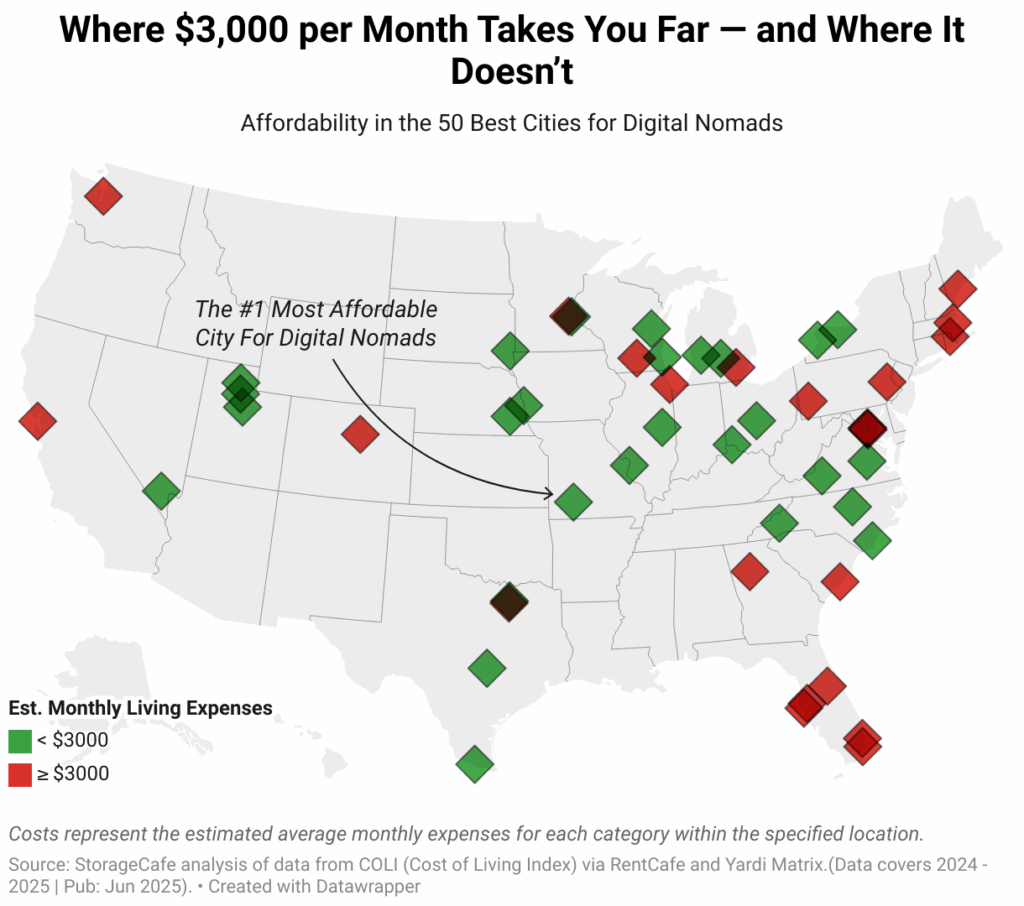
The digital nomad trend is evolving. Instead of hopping between Bali and Barcelona, today’s 18.1 million U.S. nomads are staying longer, spending more carefully, and increasingly choosing affordable cities across the U.S. over costly international hotspots.
When digital nomads say they want “affordable,” they usually mean rent under $1,000 and enough left over for life’s essentials. While not always in the spotlight, Lansing, MI, has quietly become one of the most appealing choices for remote professionals. Ranked #5 in our 2025 list of top U.S. cities under $3,000/month, Lansing offers affordability without sacrificing accessibility or quality of life.
With an average rent of $1,039/month, groceries at around $585/month, and coworking memberships priced at $150/month, Lansing provides nomads with financial breathing room.
Want to see how other cities rank in digital nomad friendliness? Check out the full study here: https://www.storagecafe.com/blog/best-places-for-digital-nomads/.
- St. Louis, MO, ranks as the top U.S. city for digital nomads, thanks to its winning combination of lifestyle perks, digital readiness and affordability.
- When it comes to digital readiness, Austin, TX, takes the lead — boasting plentiful coworking spaces, a thriving remote work scene, and top-tier internet speeds.
- Budget-conscious nomads will find the best value in Midwest cities such as Springfield, MO, and Lansing, MI, where it’s easy to meet live-work-play goals while staying under $3,000 per month.
- Among the top 50 cities for digital nomads, you’ll find the cheapest DIY breakfasts in Allen, TX; the best savings on whole milk with corn flakes in Springfield, MO; and the most affordable coffee in Buffalo, NY.
- Wyoming and Washington emerge as top departure zones for digital nomads, based on a composite index, including outmigration of Gen Zers and Millennials, as well as online search interest in digital nomadism and self storage.
Digital nomads now count over 18.1 million workers in the U.S. — and the lifestyle keeps growing fans.
Born from the ashes of the 2008 financial crash and supercharged by the COVID-19 lockdowns, remote work sparked a wave of mobile professionals who have since reshaped the economy — and the world around them. In fact, digital nomads helped normalize and mainstream remote work long before the pandemic, directly fueling the explosive growth of co-working spaces in both cities and more remote areas. Their need for flexible work hubs accelerated the rise of WeWork-style models and inspired new formats like work cafés and co-working/co-living communities. The trend also gave a boost to the self storage industry, as nomads ditched long-term leases and turned to storage units to safeguard their belongings while exploring the world.
Moreover, digital nomads have triggered notable demographic shifts — from population growth in smaller, affordable cities with a high quality of life (think Richmond, VA, and McAllen, TX) to the revitalization of niche communities. Places like Tampa, FL, and Portland, ME — traditionally known as retirement havens — have seen a significant uptick in remote workers in recent years, driving a demographic shift that is helping reshape their economic and cultural landscapes. Once overlooked by young professionals, these locations are now on the radar for their strong broadband, access to nature and lower cost of living.
Digital nomadism in 2025: How are cities stepping up?
Despite return-to-office mandates and economic uncertainty, digital nomadism isn’t slowing — it’s accelerating. Online searches for “digital nomad” rose 54% from 2023 to 2024, and in January 2025, they more than doubled year-over-year. A significant spike in November 2024 reflects increased interest among young professionals seeking broader horizons amid global social and political shifts.
According to MBO Partners, 11% of U.S. workers now identify as digital nomads — a 147% increase since 2019. Far from disappearing, nomadism is simply evolving, with today’s mobile professionals many forms. Aside from traditional nomads who spend between one and three months in a location, there are the slowmads, who take their time, immersing themselves in local culture before moving on. More recently, tethered nomads are gaining ground. They maintain a home base while exploring nearby regions — blending flexibility with stability.
These new nomads seek more than just adventure. They want to live well without overspending, stay productive without sacrificing wellness and settle in cities that offer the right mix of lifestyle, digital infrastructure, affordability and safety. And in light of global unrest, many are choosing to stay closer to home.
“Interestingly, more nomads are choosing to stay within the U.S. instead of traveling abroad,” says Dave Cassar, Chief Revenue Officer at MBO Partners.“In 2024, 51% of digital nomads planned to travel exclusively within the U.S., up from 42% in 2022. Many are working from national parks, revitalized small towns or cities with strong remote work infrastructure, like Austin, Denver and Asheville. This move toward domestic travel often reflects a desire to stay closer to family, clients or within familiar time zones.”
Where digital nomads can have their cake and eat it too
At StorageCafe, we’ve been closely tracking population mobility as it directly influences the self storage market. So, we asked: Where can digital nomads find the perfect mix of flexibility, affordability and convenience?
To identify the most well-rounded cities for remote workers, we created a Live-Work-Play Index that considers:
- Lifestyle
- Digital readiness and work infrastructure
- Safety and health
- Affordability
We then ranked 169 major U.S. cities based on these indicators to see how well they cater to digital nomads. The result? A shortlist of ideal destinations for anyone ready to embrace the lifestyle – pack their bags, place what matters in storage, and live with one foot in the sand (or snow) and the other in a Zoom meeting.
The top contenders? St. Louis, MO, followed by Pittsburgh, PA, and Austin, TX, emerge as the cities best suited for those who want to work and play away from home. St. Louis stands out for its lifestyle perks, while Austin ranks as the most digitally ready city nationwide – with plenty of coworking spaces, free Wi-Fi hotspots, and blazing-fast internet. For budget-conscious nomads aiming to cap monthly expenses at $3,000, Midwest cities dominate, led by Springfield, MO.
With a growing fan base and an expanding range of jobs that can be accessed from anywhere, the idea of “enjoying the ride” takes on a whole new meaning. If you’re sold on the lifestyle, read on to discover the most digital-nomad-friendly cities – places that combine strong community, reliable connectivity, great recreational options and a comfortable lifestyle that won’t break the bank.
Top 10 U.S. cities for digital nomads
Here are the ten best cities to have on your radar when scouting your next destination as a digital nomad. After all, geo-arbitrage works best when you know the numbers.
1. St. Louis, MO
Shines in parks, retail, and outdoor leisure — the underrated gem of digital nomading
Modern, walkable and affordable, St. Louis tops the list as the #1 city for digital nomads — offering an ideal blend of digital readiness and lifestyle perks. With some of the fastest internet speeds in the country and a solid network of coworking spaces, your workflow won’t miss a beat.
Nicknamed “The Gateway to the West,” the city also opens the door to rich leisure opportunities — from vibrant retail corridors to scenic parks along the Mississippi River. It ranks #4 in overall lifestyle offerings, boasting the fifth highest number of parks per 10,000 residents, plus a lively arts, music and entertainment scene that appeals to those seeking culture and community alongside career.
Housing is a major win here. You can live affordably even in historic neighborhoods near the city center – something that’s becoming rare in larger metros like Chicago. That affordability extends to daily living costs, making it easier for nomads to enjoy urban life without stretching their budgets.
Its central U.S. location is another edge, offering seamless access to major highways and airports. Whether you’re road-tripping or catching a quick flight, St. Louis makes a convenient launchpad for digital nomads on the go.
2. Pittsburgh, PA
Shines in retail, leisure, and outdoor access
Pittsburgh strikes a compelling balance between digital connectivity and lifestyle appeal. Known as The City of Bridges, it ranks in the top ten for both leisure (#9) and retail offerings (#10). From shopping and dining at The Waterfront to grabbing bites in the buzzing Strip District, this city knows how to keep things vibrant.
Need a screen break? Hop on the Duquesne Incline for sweeping skyline views, kayak the Monongahela, or hike the Montour Trail for a deeper dive into nature. If staying closer to your laptop is the plan, you’re still in luck — Pittsburgh is full of outdoor cafés and green spaces, perfect for setting up shop in the sunshine.
It’s like Philadelphia’s cooler, more affordable cousin — serving up all the culture, food and character without the sticker shock.
3. Austin, TX
Shines in remote worker community, free Wi-Fi spots, coworking spaces, internet speed
Austin has Digital Nomad infrastructure down pat, and the data proves it: 28% of working Austinites are remote, while the city is top 15 in internet speed and coworking spaces.
“After managing remote teams across the U.S., I’ve found Austin to be the sweet spot for digital nomads, with fantastic co-working spaces like WeWork on Congress Avenue and a thriving tech community,” says Daniel Trotter, Co-Founder, PPC Geeks.
Don’t worry about turning on your mobile data, either — Austin ranks fourth nationwide with 156 free Wi-Fi spots. So, not only can you work unimpeded by slow internet, but you can also build a community of like-minded individuals — one of the most understated aspects of the digital nomad lifestyle.








